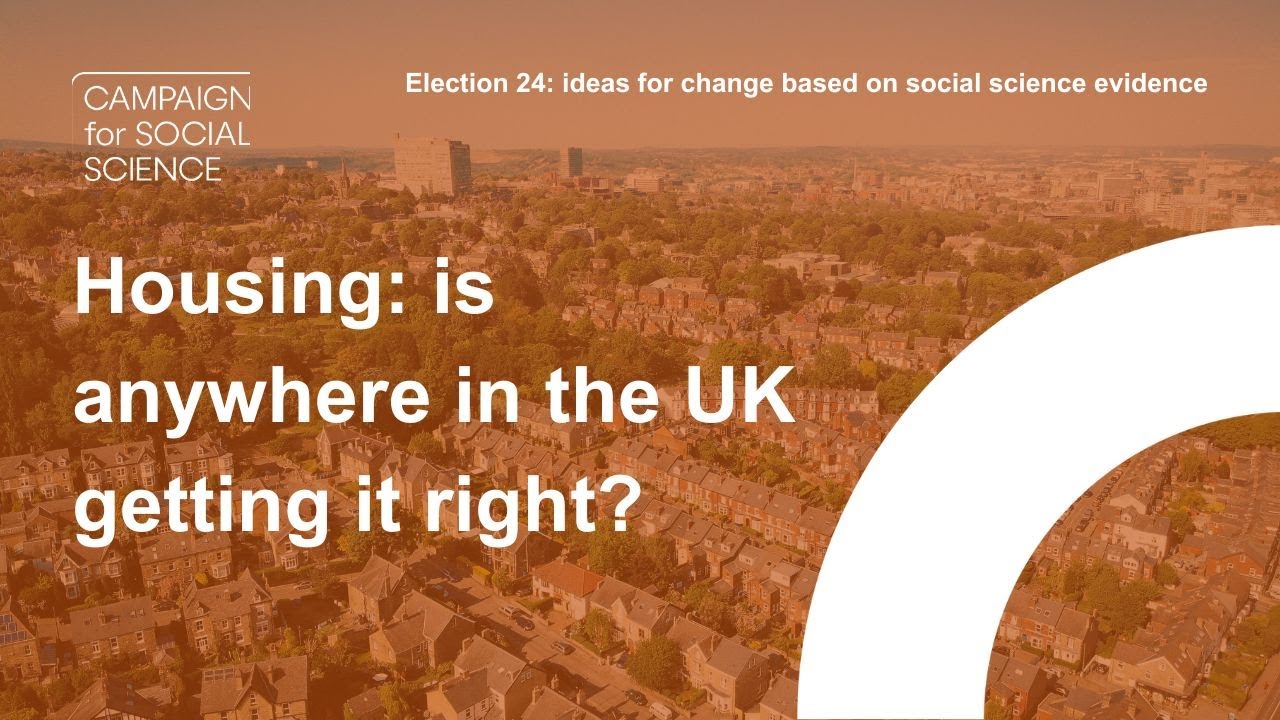“We need to consider the social impact of not getting housing right and the potential gains and societal gains of getting housing right.”
As part of our Campaign for Social Science’s recent project, Election 24: ideas for change based on social science evidence, earlier this week we held a webinar featuring Professor Glen Bramley FAcSS, Professor Nick Gallent FAcSS and Polly Neate CBE FAcSS LLD(hc) who discussed the various challenges presented by the UK’s current housing crisis and the measures needed to address them.
In the webinar, chaired by Gavin Smart FAcSS, of the Chartered Housing Institute, our panellists offered their insights and perspectives on social housing issues, London’s overheated housing market, the impact of second homeowners on rural communities and the role of the planning system in tackling these challenges.
Polly, Chief Executive of Shelter, began by providing the context to the severity of the issues facing many Londoners as they navigate the capital’s housing market – from affordable renting to social housing. She pointed out that, although these issues are increasing across the country, London is a particularly severe example on several fronts. She said, “Buying is out of reach for people on average incomes – the average London house price is 12 times the average London salary. So, buying is increasingly unaffordable.”
In addition, Polly highlighted how rental listings are down 41% compared to 2017, and the availability of family homes has declined by almost half since then too. Rental prices have also dramatically increased, as well as those impacted by no fault evictions, and in the last 12 months alone there has been a 5% annual increase in the number of households on the social housing waiting list in the capital.
Polly said, “London was the English region with the highest annual rent inflation in the 12 months to March 2024 at 11.2%. This is the highest annual percentage change since records began in 2006.”
The impacts of all of this are that a quarter of London residents are left in poverty after housing costs, rough sleeping in the capital has more than doubled since 2013, around one child in every school class in London is homeless and living in temporary accommodation, and 79% of households living in temporary accommodation have been there for more than a year, which is well over the national average.
Polly also referred to housing affordability undermining public sector recruitment in the capital, with those on public sector wages being unable to afford to live in the areas they work, illustrated by the fact that the growth in public sector employee recruitment in London was lower than the national average.
But, as Polly shared, lessons can be learned from other parts of the country. In terms of investment in social housing, she used the example of the Goldsmith Street Development in Norwich which has high quality, highly affordable social housing with high standards of energy efficiency. She also referred to the various measures put in place in Scotland to increase security for private renters in the country. As Polly said, “Renters need protection from no fault eviction, but they also need protection from frequent rent increases because if you abolish no fault eviction without rent regulation, of course, you can force people out by default by unreasonable increases in their rent.”
Nick, Professor of Housing and Planning at UCL, then explored the problem of second homes and their impact on rural housing markets. He opened his presentation by explaining the differences between second homes being used for seasonal personal use and those being used for platform-based rentals and holiday lets.
Nick said, “The thing that we should worry about, if we’re going to worry, is extractions from the regular housing stock. So, homes that people need being shifted to seasonal residency and long-term rent lets becoming short term.” He argued that holiday letting of property which was not residential when originally built can be a source of local business income and support rural economies.
He said, “Rural areas, in many instances, are associated with low wages, with housing pressures, not only from second homes but from retirement migrants and therefore rural housing markets connect urban wage economies to these more low wage economies.”
Nick used the example of research conducted by Cornwall Council who investigated house prices in different areas and how they were being affected by concentrations of second homes. He said, “House prices in villages with high concentrations of second homes, that is more than 35% of the stock used seasonally, had house prices that were 85% higher than the Cornish average.” Nick did highlight that it’s not only second homes that impact on house prices, but also retirement pressures and people commuting from these villages to jobs elsewhere.
He went on to look at the social impacts of local people being outcompeted by external buyers and displaced away from their local communities, before highlighting that second homes increase land prices which is a large barrier in supplying affordable homes in rural villages.
As to potential solutions, Nick pointed to Wales which has implemented an increase in council tax rates for second homes, as a means to ensure more money is back into the local economy by those taking housing stock out of the local community.
Following Nick’s presentation, Glen, Professor of Urban Studies at Heriot-Watt University, took a closer look at social housing provision and reflected on the role of the planning system in addressing this.
Referring to his research from 2018/19 which was used by a House of Commons Select Committee in 2020, and drawing on updated research since, Glen explored the different housing requirements over the short, medium and long term across a range of different housing scenarios, including overall numbers, affordability and tenure mix.
Using his modelling research, he identified that as housing supply increases, so does the affordability of market rents and that, as a result, homelessness can also be expected to decrease.
He also highlighted that increasing supply has a steady improving effect on the number of homeless people in temporary accommodation, in addition to other non-supply measures such as more effective use of housing.
Looking to scenarios in the social rented sector, Glen also pointed out there is huge regional variation within England as to how quickly a household in this sector might be rehoused within 12 months – and that the south of England was particularly pressurised. He said, “In housing the place that needs levelling up is London and the south, not the north, in terms of housing access, affordability and housing need.”
Glen then went on to explain how the levels of new housing required to address the current shortfall has remained consistent over the past few years at approximately 300,000, and that, if applied rigorously, planning obligations could fund a lot of the social and affordable housing needed. Glen ended his presentation on an optimistic note stating, “Substantial increases in total and social housing provision are possible even within the current subsidy budget.”
Watch the recording below to hear more from our speakers.

